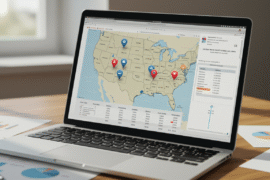This article may contain references to products or services from one or more of our advertisers or partners. We may receive compensation when you click on links to those products or services. Nonetheless, our opinions are our own.
The information presented in this article is accurate to the best of our knowledge at the time of publication. However, information is subject to change, and no guarantees are made about the continued accuracy or completeness of this content after its publication date.
- Introduction
- Open Interest in Trading
- Definition of Open Interest
- How Open Interest Differs from Volume
- Why Open Interest Matters for Traders
- Using Open Interest in Market Analysis
- Impact on Price Movements and Trends
- Open Interest Basics for New Traders
- Getting Started with Open Interest
- How to Apply Open Interest in Trading
- Final Thoughts
- Frequently Asked Questions
- Recommended Reads
Introduction
When you are in the market, it is important to know about open interest to make your trading feel better. In options trading, open interest shows the number of contracts that people still hold at the end of the day. This is not the same as trading volume, because it stays focused on positions that are still open. It can tell you a lot about how easy it is to buy or sell and what people feel about the market. This information helps people look at trends and see what is happening in the market. When you use this data, it can help make your plan work better, and you feel more sure about your next step.
Open Interest in Trading
Open interest is very important in options trading. It tells you about the number of trades that are still open and not yet settled. Every day, people look at this to see how many options contracts traders are opening and closing. This keeps track of who is active and gives you a steady look at the market.
On any trading day, open interest changes because new contracts get made and old positions get closed. When open interest is high, it shows there is more activity and more people trading. This can help make trading work better. If open interest is low, it may mean there are fewer people taking part in the market.
Definition of Open Interest
Open interest shows the total number of options contracts that traders still have at the end of the trading day. These contracts are not closed, finished, expired, or used yet. It gives a quick look at how many active trades are happening in the options market right now.
Each type, like call options and put options, works out its open interest on its own. For call options, open interest shows how many contracts allow people to buy the asset at a set price. For put options, open interest shows contracts that let people sell the asset.

The way open interest changes is very important. For instance, when more people open new trades than close them, the open interest goes up. This shows there is more action and interest in the market. On the other hand, if people close more trades than they open, the open interest goes down. This means there is less participation at that time. These changes help people see what other traders feel about the market and how easy it is to trade.
How Open Interest Differs from Volume
Both open interest and trading volume are important in options trading, but they do different things. Trading volume is the number of contracts traded on a given day. It tells you how active the market is right now. Open interest, on the other hand, shows the number of contracts that are still open. This tells you how many people are still involved over time, not just in the moment.
Open interest goes up when there are more new contracts made than closed ones. It goes down when people close out or finish their trades. Trading volume shows how many trades happen each day. Each day, it starts fresh. Open interest keeps adding up as long as the contracts are still open. It only goes down when the contracts end or are sold off.
For example, when the trading day is busy, you may see high volume. But if all the positions that are opened during the day are also closed in the same period, open interest does not change. These two measures work together to help traders know more about market liquidity and where prices might go next.
Why Open Interest Matters for Traders
Knowing about open interest is very good for making strong trading plans. When there is higher open interest, it shows there are more people in the market and more money moving around. This helps traders to get in and out of trades more easily. Open interest can also show what people feel about the market. As open interest goes up, it often means a trend is still going or there is more action coming.
Also, when open interest goes up or down, it shows if new money is coming into the market or leaving it. This can help traders figure out what may happen with prices. When you use this alongside other tools, open interest is very important for good trade choices.
Voted "Best Overall Budgeting App" by Forbes and WSJ
Monarch Money helps you budget, track spending, set goals, and plan your financial future—all in one app.
Get 50% OFF your first year with code MONARCHVIP
Using Open Interest in Market Analysis
Open interest is very helpful when you look at the market. It tells you the number of trades that are still open and how easy it is to buy or sell. This information can help you see what people are doing in the market. You can find out if they are starting new trades or ending old ones. It gives a good look at what traders are thinking and how the market is moving.
For example, when there are more options contracts and the prices keep going up, it usually means that people feel good about the market. In the same way, if you see less open interest while there is still a trend, it can show that the trend is slowing down. If you know these things, you can better judge how strong today’s market moves are.
High open interest often shows that people are finding prices clearer. It also means there are smaller gaps between buying and selling prices, which can make trading work better. When you look at how open interest moves with price changes, traders can get a good idea about what is going to happen in the market soon or if the trend will keep going. This way of looking at things is very important when money markets feel shaky, because having clear data about cash and what people feel helps make choices you can count on.
Impact on Price Movements and Trends
Open interest has a big effect on the way prices move and how strong each trend is. It works like a sign that shows what is going on in the market. When there is more open interest and the stock price is also going up, this can mean the trend is likely to stay up and that more people are trading. In the same way, if prices are going down but open interest is getting higher, this could mean that a strong downtrend is starting to build.
Changes in open interest can also show when the market might turn. If the price stops moving much but the open interest stays high, this can point to a shift in direction coming. When there has been a long uptrend and that starts to slow down with less open interest, this often means a change is near.
Also, when there is more open interest at certain strike prices, it can make prices move as the expiration date gets closer. These changes show how people in the market change their positions when events are about to happen. If traders watch the market often, they can make their plans match what most people feel, and with how easy it is to trade. This can help lower risks and help get good chances in the market.
Open Interest Basics for New Traders
Beginners need to know the basics of open interest. This can help them feel more sure when they start to trade options. Open interest counts how many active positions are in the market. It shows how easy it is to buy or sell and how many people are taking part in trades.
Open interest gets shared every day. It shows the net change between new contracts and old contracts that are closed. When open interest goes up, it usually means more people are in the market. This can show that there are chances to take based on the latest trends. But if open interest is low, it can show problems. For example, there might be bigger gaps between the buy and sell prices, or not much trading in some options.
How Open Interest Is Calculated
The way to find open interest is simple. It is the total of new contracts made, minus the contracts that have been closed, on a certain day. Below is a text table that shows how the calculation works:
| Date | Activity | Open Interest |
|---|---|---|
| Day 1 | Initial: 5,000 contracts | 5,000 |
| Day 2 | +1,000 new contracts; -500 closed | 5,500 |
| Day 3 | +700 new contracts; -1,000 closed | 5,200 |
| Day 4 | Big market event: +2,500 new; -1,000 closed | 6,700 |
How to do this calculation helps traders see what is going on in the market. Open interest shows the whole range of active positions that traders have. This helps people make better choices when they trade.
What Open Interest Changes Can Signal
Changes in open interest give you important clues about what people feel and do in the market. When open interest goes up, new money comes in. This shows that more traders want to start new long or short positions instead of closing old ones. The rise points to stronger feelings in the market, and it often means there is more liquidity.
On the other hand, if open interest goes down, it means more people are closing or ending their positions than those starting new ones. This drop may show that interest in the market is fading or that the direction of prices might soon change. When open interest drops as prices get weak, it shows that people are not sure about where the market is headed now.
These changes help traders know if they should look for a strong trend to keep going or get ready for something different. When traders use open interest analysis with other tools, they can make their plans better. This also helps them act fast and well when the market moves.
Getting Started with Open Interest
Starting with open interest in options trading can be easy. Keep your focus on how this number shows you the open trades that are still active. It can help you see the liquidity and mood of the market across the strike prices.
Start by looking at whether open interest is going up or down. When an options contract has a high open interest, it is easier to trade, and the difference between the buy and sell prices is smaller. But if there is low open interest, it might mean fewer people trade it. If you look at open interest along with price changes, you can get a better idea of what may happen in the options market.
Tools and Resources for Tracking Open Interest
If you want to use open interest well, you need to have good resources and trading tools. Here are some important tools that help make analysis easy:
- Trading platforms: Some top platforms like Thinkorswim and Interactive Brokers let you see open interest data right with price charts.
- Options chains: These platforms show important details about contracts. You get strike prices, expiration dates, open interest, and trading volume.
- Market analysis tools: Tools, such as TradingView, help you see open interest trends and how prices move.
- Educational resources: Websites like Investopedia and tastylive give insights into how open interest can help you make better trading plans.
With these tools, traders get the power to watch what is happening in the market. They can see changes in open interest and then change what they do if needed. This helps them make good plans and be sure about their choices.
Common Open Interest Terms Explained
Knowing the common words linked to open interest helps options traders see things more clearly.
- Strike price: The set price at which a contract can be used, and this is important to see how people feel about the market.
- Offsetting trade: You close a contract by making another trade that goes against it.
- Options trading volume: This is the total number of contracts traded in one day. It is not the same as open interest.
- Active positions: These are contracts that are still open and not settled yet. They are used to figure out the open interest.
Knowing this kind of language helps keep things clear. It also helps people study open interest trends better. This can help new and skilled traders make good choices.
How to Apply Open Interest in Trading
Open interest can help you with your options trading strategy if you use it the right way. Start by looking at what is going on in the markets and with the right tools for you. Pay attention to times when there is high open interest along with changes in price. This can give you good and useful information.
Next, look at open interest data at different strike prices. This can help you find out more about liquidity and see what people feel about the market. When you use this with things like trading volume, open interest can give you a better look at the market. It helps you make decisions that are based on more facts.
1. Identifying Relevant Markets and Instruments
To begin, look for the right markets and tools where open interest analysis can help. Pay close attention to the options market’s active contracts. This includes call options for stocks that can move a lot. Equities or ETFs often give you a good place to base your research and make better decisions.
Next, see if there are big changes in open interest at some strike prices in the market. For example, there may be more people buying call options for a stock. This can show that people feel good about the stock and think it will go up. On the other hand, if people get more put options, it can mean they feel bad about the stock and think it will go down.
Choosing the right market helps you to focus on jobs linked to feelings and how much money moves in and out. This will lay the ground for you to use your plan in the right way.
2. Analyzing Open Interest Data for Trade Decisions
Looking at open interest data can help you make better trade decisions. First, check for higher open interest levels. They show more activity and make it easy to get in or out of trades. These numbers help you spot good times to start or end a trade.
Next, watch how open interest changes when prices move. For example, if prices go up and open interest also goes up, it often shows that more people feel good about the market. On the other hand, if open interest goes down while prices are falling, it might mean less trust in the move, and there could be a change soon.
Using open interest data with trading volume and the way the market moves can help you make trading plans that work well as things change. This can help you get ahead and feel sure when the market goes up and down.
Final Thoughts
Knowing about open interest in trading is important for people who want to make smart choices. Open interest is a good sign of what is happening in the market. It helps you see where prices might go and what trends to look for. It does not matter if you are just starting or if you have been trading for years. Learning how open interest works can make your trading plan better and help you read the market. If you look at open interest with a few other things, you can feel the mood of the market and make better choices when you trade. When you keep trading, remember what you learned here about open interest to use it well.
Frequently Asked Questions
How can open interest help predict market trends?
Open interest shows how strong the current trends are. When open interest rises and prices also rise, it often means there is a bullish feel in the market. If open interest falls, it may show the trend is losing strength.
Can you use open interest with both stocks and options?
Yes, you can use open interest for both stocks and options. In options trading, open interest shows how many active contracts there are. For stocks, trading volume is more common.
Does open interest mean high liquidity?
Not always. High open interest shows many contracts are open, but it does not always mean trades can be made quickly or easily.
Why is open interest not enough on its own?
Relying only on open interest can be risky. It does not show direction and can be read the wrong way. Use it with other tools to get a full view of the market.

Reviewed and edited by Albert Fang.
See a typo or want to suggest an edit/revision to the content? Use the contact us form to provide feedback.
At FangWallet, we value editorial integrity and open collaboration in curating quality content for readers to enjoy. Much appreciated for the assist.
Did you like our article and find it insightful? We encourage sharing the article link with family and friends to benefit as well - better yet, sharing on social media. Thank you for the support! 🍉
Article Title: What is Open Interest in Trading?
https://fangwallet.com/2025/06/26/what-is-open-interest-in-trading/The FangWallet Promise
FangWallet is an editorially independent resource - founded on breaking down challenging financial concepts for anyone to understand since 2014. While we adhere to editorial integrity, note that this post may contain references to products from our partners.
The FangWallet promise is always to have your best interest in mind and be transparent and honest about the financial picture.
Become an Insider

Subscribe to get a free daily budget planner printable to help get your money on track!
Make passive money the right way. No spam.
Editorial Disclaimer: The editorial content on this page is not provided by any of the companies mentioned. The opinions expressed here are the author's alone.
The content of this website is for informational purposes only and does not represent investment advice, or an offer or solicitation to buy or sell any security, investment, or product. Investors are encouraged to do their own due diligence, and, if necessary, consult professional advising before making any investment decisions. Investing involves a high degree of risk, and financial losses may occur including the potential loss of principal.
Source Citation References:
+ Inspo
There are no additional citations or references to note for this article at this time.











































